鲁斯·巴德·金斯伯格,最高法院大法官和冠军妇女权利,已去世,享年87岁。
最高法院女发言人凯西·阿尔贝格说:“由于转移性胰腺癌的并发症,助理法官鲁斯·巴德·金斯伯格今晚在她位于华盛顿特区的家中去世,死于家人的陪伴下。”。
她仍在最高法院任职期间死亡,这是自由派人士长期以来一直担心的情况,为她创造了一个难得的选举年机会总统唐纳德·特朗普提名一名保守派替代者,引发一场激烈的政治斗争。
“我们的国家失去了一位具有历史地位的法学家。我们在最高法院失去了一位珍贵的同事,”首席大法官约翰·罗伯茨在一份声明中说。“今天,我们哀悼,但我们坚信,后代将记住我们所熟知的鲁斯·巴德·金斯伯格——一位不知疲倦、坚定的正义捍卫者。”
金斯堡已经成为20世纪80年代的旗手法院的自由派在她担任法官的四分之一多世纪里,她撰写了里程碑式的观点,促进了美国残疾人和移民的性别平等和权利。
她同样因在重大社会问题上的激烈反对而闻名肯定行动同工同酬——这为她在进步人士中赢得了某种摇滚明星的地位,并激励立法者如何立法进行社会变革。
“在过去的26年里,她甚至远远超出了我的预期,”前比尔·克林顿总统,谁任命金斯伯格为法庭法官,2019年在他的总统图书馆举行的一次纪念正义的活动上。“我们喜欢她,因为在一个渴望那些不试图欺骗你的人的世界里,她看起来完全在水平上,那些在水平上的人。”
金斯伯格是第二位加入高等法院的女性桑德拉·戴·奥康纳在1993年,并成为历史上服务时间最长的女性。她是第一位女性犹太法官。
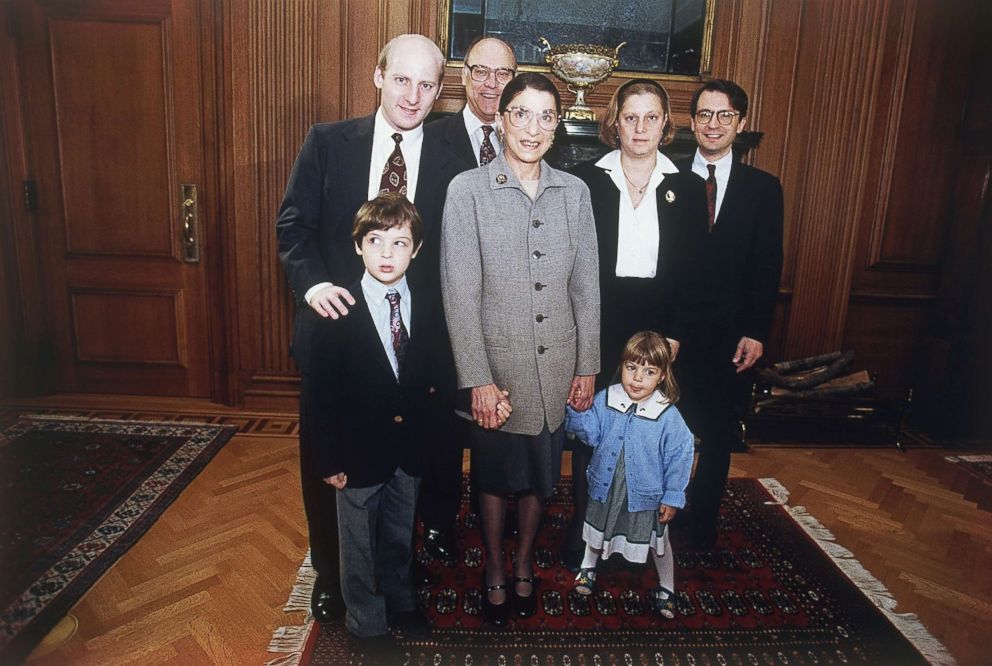
道格·米尔斯/美联社照片
1993年10月1日,最高法院大法官鲁斯·巴德·金斯伯格(中)和她的家人在华盛顿法院合影。从左至右分别是:女婿乔治·斯帕拉、女儿简·金斯伯格、丈夫马丁、儿子詹姆斯·金斯伯格。法官?美国的孙子克拉拉·斯佩拉和保罗·斯佩拉在前面。
“露丝·金斯堡是一个灵感,”他说布雷特·卡瓦诺法官最高法院的最新成员,在2019年作为法官的首次公开演讲中。他称她为“奉献、勤奋和慷慨的灵魂”
首席大法官约翰·罗伯茨称金斯堡为“摇滚明星”
索尼娅·索托马约尔大法官是第三位女性,也是第一位被任命为最高法院法官的拉丁裔,她将自己的同事比作“钢铁木兰花”“她外表脆弱,”索托马约尔在2018年谈到金斯堡时说,“但她背后有一根铁棒。”
在她的整个职业生涯中,金斯伯格蔑视性别规范和对她的勇气的怀疑。
最高法院女发言人凯西·阿尔贝格说:“由于转移性胰腺癌的并发症,助理法官鲁斯·巴德·金斯伯格今晚在家人的陪同下在家中去世。”。
她是1956年哈佛法学院500名学生中仅有的九名女性之一,也是著名的《哈佛法律评论》的第一名女性成员。她后来跟随在曼哈顿找到工作的心爱的丈夫马蒂,转到了哥伦比亚大学法学院。
1959年,当她以全班第一的成绩毕业,却没有得到纽约律师事务所的一份工作时,她接受了曼哈顿一名联邦法官的职位。
金斯伯格并没有退缩,而是通过学术界从事法律研究,先是在哥伦比亚大学担任研究员,后来加入新泽西州罗格斯大学(Rutgers University)的教师队伍,成为第一批在美国法学院任教的女性之一。
20世纪70年代,金斯伯格开始与美国公民自由联盟一起处理性别歧视案件,并共同创建了该组织的妇女权利项目。她在最高法院辩论了六个案子,赢了其中的五个。
她代表男性和女性进行辩论,这是打击性别不平等战略的一部分,吸引了以男性为主的司法机构。在1975年温伯格诉维森菲尔德一案中,金斯伯格代表一名鳏夫,试图收回他妻子的社会保障遗属津贴,当时这种津贴只发放给寡妇。她赢了。
“我在做我妈妈教我做的事情——成为一名好老师,”金斯伯格去年在北卡罗来纳州的梅雷迪思学院告诉一群人。“这让法庭明白,这些对女性没有好处,让她们看到现实才是挑战。”
吉米·卡特总统1980年,她被任命为美国上诉法院法官,在此工作了13年,撰写了数百份意见书。“吉米·卡特开始的是改变司法机构的面貌,”她谈到自己和其他40名女性的提名时说,创下了纪录。
1993年,拜伦·怀特法官宣布从最高法院退休,这给了年轻的总统比尔·克林顿第一次任命的机会,就在上任七个月后。克林顿在椭圆形办公室的一次面对面会议后,在金斯堡安顿下来之前考虑了几个候选人。
“她才华横溢,很有头脑。她严谨但热心。她有很好的幽默感和明智的、可实现的司法哲学,”克林顿最近在思考他的选择时说。
“我认为她有能力在一个日益两极分化的国家找到共同点,”他说。“她已经证明自己是一个治疗师。总之我喜欢她,我相信她。”
1993年8月3日,美国参议院以96票对3票批准了金斯堡的提名。
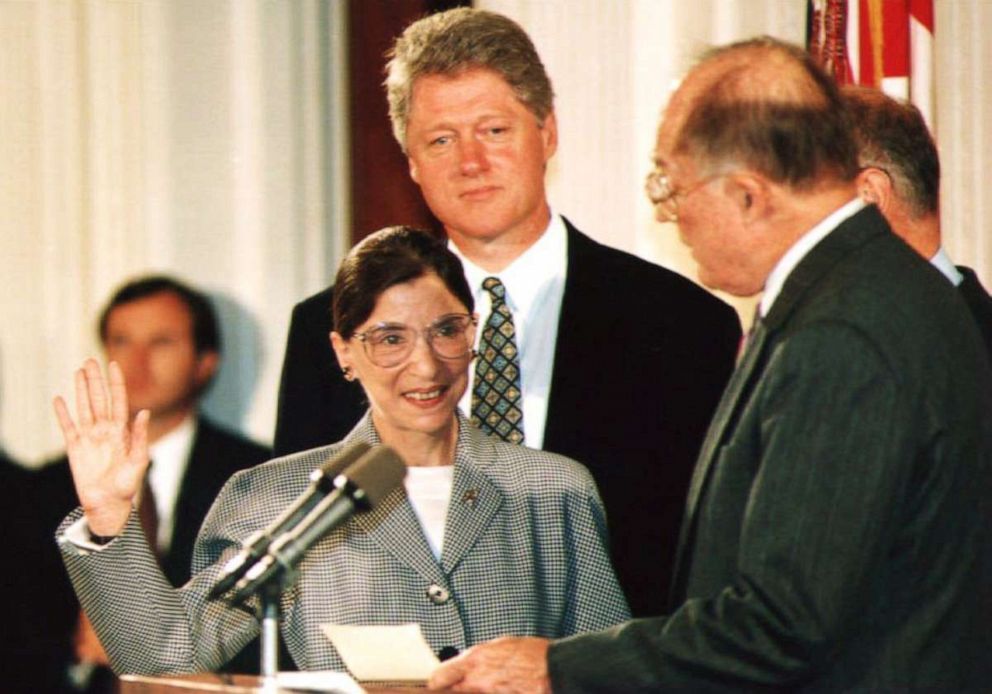
Kort Duce/AFP/Getty Images,FILE
1993年8月10日,在比尔·克林顿总统的注视下,美国最高法院首席大法官威廉·伦奎斯特主持新任命的美国最高法院法官鲁斯·巴德·金斯伯格的就职宣誓。
司法遗产
她的司法哲学主张做出精心设计、深思熟虑的决定,这些决定不会超越公众舆论或立法者制定政策的责任。
金斯伯格在1973年罗伊诉韦德案的意见中对最高法院的推理深表遗憾,该意见将堕胎权建立在宪法隐私权而不是平等保护原则的基础上。
尽管金斯伯格坚定地捍卫生殖权利,但她认为法院走得太远、太快,在许多州正在采取措施自行“放开”堕胎法的时候,却提出了一种“伟大的哲学”。
金斯伯格在1993年《华盛顿邮报》的一篇专栏文章中写道:“没有经过深思熟虑的动议,罗伊案的裁决几乎没有一个州的法律完全符合法院对堕胎法规的描述,这仍然是允许的。”。围绕这一非同寻常的决定,一场组织严密、呼声高涨的生命权运动团结起来,并在相当长的一段时间内成功地将立法潮流推向了相反的方向
在她的职业生涯中,她撰写了几十篇多数意见,在她的同事中以速度和准确性赢得了声誉。
“作为诉讼律师和法官,她改变了美国反歧视法的面貌,”埃琳娜·卡根法官她在2014年这样评价她的同事。
金斯伯格认为她最重要的意见之一是1996年美国诉弗吉尼亚一案,该案发现弗吉尼亚军事学院的男性专用准入政策违反了第14修正案的平等保护条款。
“培养公民士兵的目标和VMI的实施方法都不适合女性,”她在一份有五名同事参与的意见中写道。"该校在培养领导者方面令人印象深刻的记录让一些女性渴望入学。"
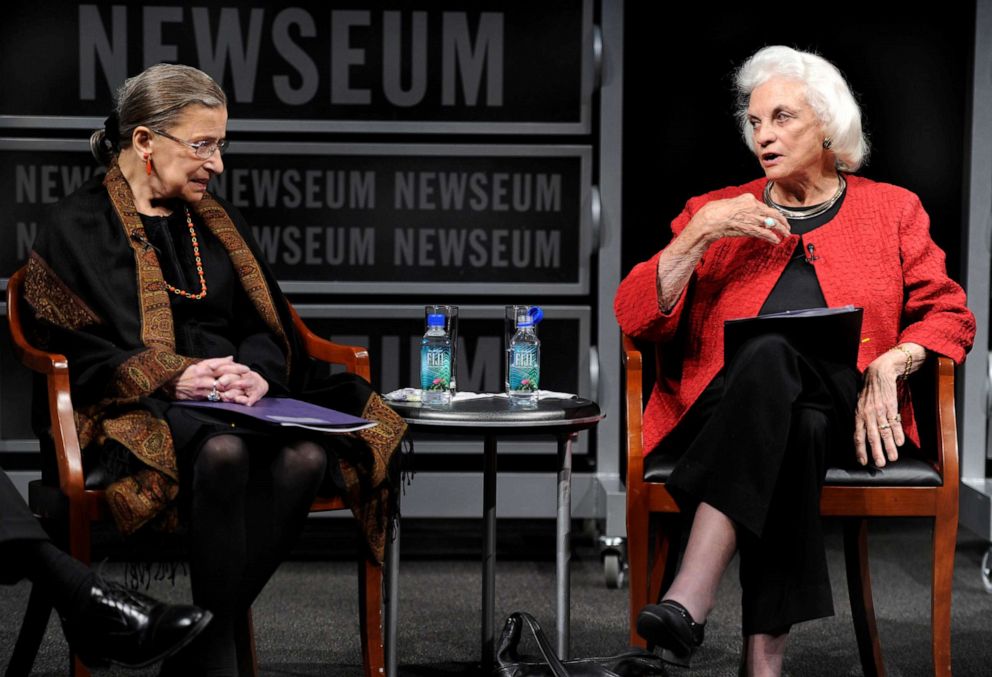
迈克·蒂勒/路透社
档案图片:2012年4月11日,美国最高法院第一位女法官桑德拉·戴·奥康纳在华盛顿纽瑟姆的一个论坛上发表演讲,纪念奥康纳首次在最高法院任职30周年。
在她的回忆录《我自己的话》中,金斯伯格写道,她认为这个案子是“20世纪70年代努力打开大门,让女性在没有人为限制的情况下渴望和实现的高潮。”
1999年,金斯伯格在奥姆斯特德诉洛杉矶一案中发表了多数意见,该意见确认美国残疾人有权在其社区获得国家资助的支持和服务,而不仅仅是指定的机构。
“我们面临的问题是,禁止歧视是否需要将精神残疾人安置在社区环境中,而不是机构中,”她写道。"我们认为,答案是有条件的肯定."
随着法庭向右侧移动,金斯伯格经常用礼貌但充满激情的异议来挑战她的同事。
她最著名的异议之一出现了布什诉戈尔这结束了有争议的2000年选举,为乔治·布什赢得总统职位扫清了道路。“我不同意,”金斯伯格尖锐地写道,在一次微妙的抗议中打破了习惯性的“我恭敬地不同意”。
“在此之前或之后,从未有过像布什诉戈尔这样的案件。从做出这一决定的那天起,一直到今天,最高法院从未在任何其他案件中引用它作为先例,我认为它将继续如此,”她在2014年的一次演讲中表示。
防护堕胎权是她任期的标志。2007年,金斯伯格在冈萨雷斯诉卡哈特案中以5比4的微弱优势否决了一项支持禁止完整扩张和提取堕胎的决定,称其“完全不合理”。
“部分生育堕胎禁令法案促进了任何合法的政府利益,这种想法非常简单,不合理,”她在异议中写道。“法院对此的辩护不能被理解为除了努力削弱法院一再宣布的权利之外的任何事情——以及对其在妇女生活中的中心地位的日益理解。”
立法者偶尔利用金斯伯格的反对意见作为新立法的灵感。
当法院在2007年支持对固特异轮胎的薪酬歧视索赔的诉讼时效时,金斯伯格宣读了她对法官的异议,并提出了一项立法修正案。
“在我们看来,法院不理解,或者说对女性成为薪酬歧视受害者的阴险方式漠不关心,”她说。
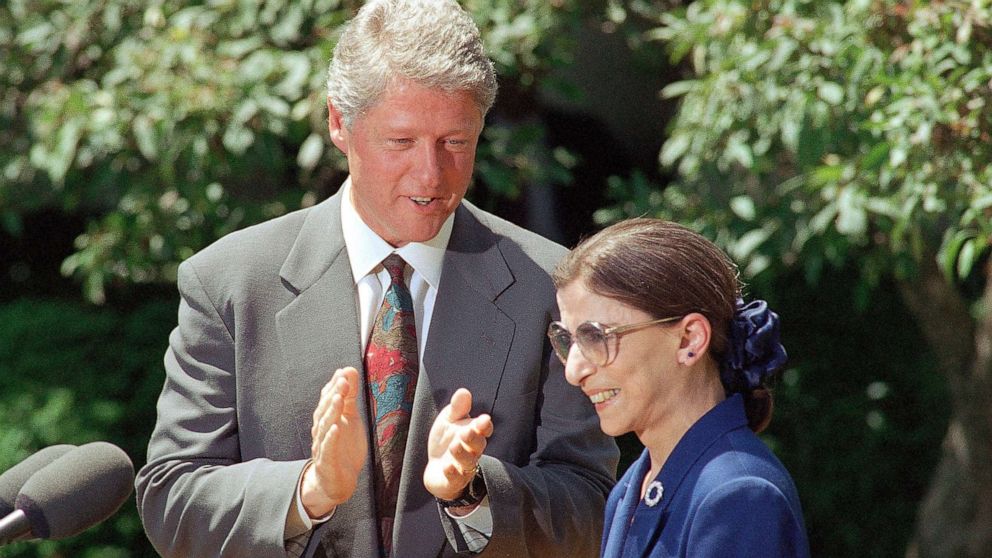
道格·米尔斯/美联社
在这张1993年6月15日的档案照片中,比尔·克林顿总统在鲁斯·巴德·金斯伯格法官宣布将提名她进入最高法院后,准备在白宫玫瑰园发表演讲时鼓掌。
两年后,在国会采取行动后,巴拉克·奥巴马总统签署了莉莉·莱德贝特公平薪酬法案以起诉固特异并在最高法院败诉的女子命名,延长了未来不平等薪酬索赔的诉讼时效。金斯堡的房间里挂着一份法律的装裱本。
金斯伯格后来说,“提出异议的想法是简单的灵魂”。“它说,‘这个女人收到的每一份薪水都是歧视的延续,所以她可以在最近一份薪水的180天内起诉,她会准时的。’这就是国会所说的:‘是的,这就是我们的意思。"
“如果有一个决定我会否决,那就是公民联盟她告诉法律教授杰弗里·罗森,2010年的里程碑式的决定取消了竞选活动中的公司支出限制我认为,我们拥有金钱可以买到的所有民主的观念,与我们的民主理想相去甚远。所以这是我单子上的第一名。"
2013年,金斯伯格强烈反对法院有争议的谢尔比县诉霍尔德案判决这推翻了1965年《投票权法案》的一个关键部分,该法案要求有歧视史的州和地方政府在修改投票法之前必须获得司法部的预先许可。
金斯伯格在她的异议中写道:“当阻止歧视性变化的预许可已经生效并继续生效时,就像在暴雨中扔掉你的雨伞,因为你没有淋湿。”
这一观点引发了新的绰号金斯堡-“臭名昭著的R.B.G。”——由一名NYU法学院学生杜撰,是已故说唱歌手臭名昭著的B.I.G .的剧本
“她很生气,然后她意识到愤怒是一种无用的情绪,”金斯伯格谈到这个学生时说。“她所做的积极的事情是在她的博客上发表我对此案的不同意见,然后这件事就开始了。”
2012年,金斯伯格写了一篇长期法庭记者杰弗里·图宾称之为“她职业生涯中最强有力的观点”的文章,支持《平价医疗法案》的合宪性。
“与几乎任何其他产品或服务的市场不同,医疗保健市场是一个所有人都不可避免地参与的市场,”她写道,为国会在宪法商业条款下的广泛权力辩护。“几乎每一个居住在美国的人,迟早都会去看医生或其他医疗保健专业人员。”
金斯伯格在2002年对NPR的尼娜·托滕伯格说:“不同意见代表着未来的时代。”。“最大的异议确实会变成法庭意见,随着时间的推移,他们的观点会逐渐成为主流观点。这就是反对者的希望:他们不是为今天而是为明天而写。”
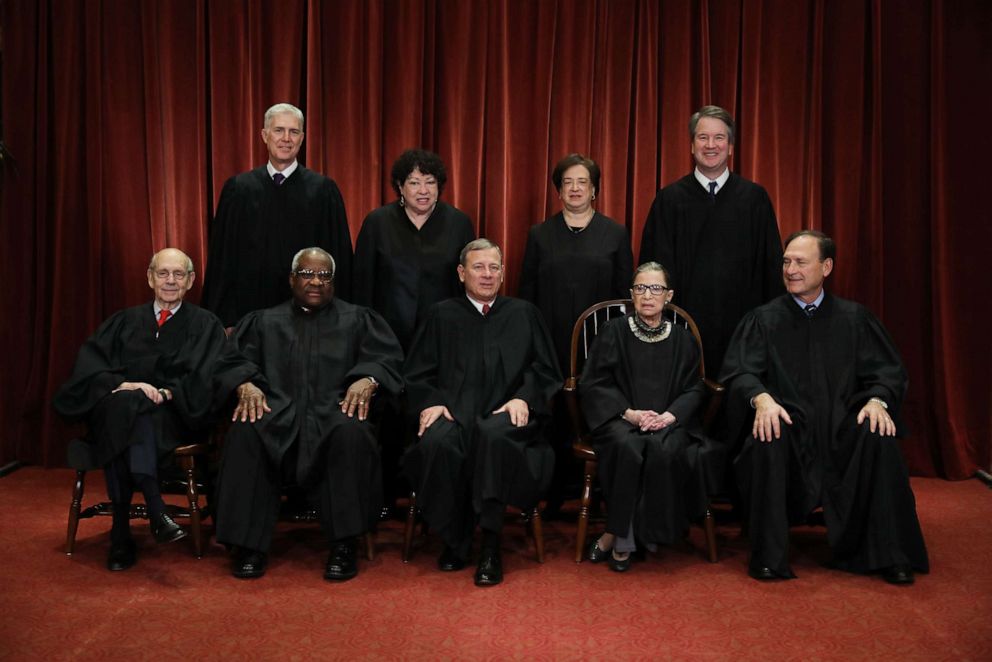
chip somodeilla/Getty Images,FILE
2018年11月30日,在华盛顿,助理法官布雷特·卡瓦诺(Brett Kavanaugh)加入法院后,助理法官鲁斯·巴德·金斯伯格和她的同事在美国最高法院集体合影。
虽然她会在意识形态上与同事发生冲突,但金斯伯格甚至向她最保守的同事伸出了友谊之手,包括著名的已故同事安东宁·斯卡利亚法官。
“他被提名的时候,虽然他的观点很广为人知,但还是被一致确认了。金斯伯格在最近与法学教授罗森的一次谈话中谈到她的朋友时说:“我几乎做到了——对我的投票是96比3。”。“今天不会这样,但你不认为这是我们应该寻求回归的方向吗?”
金斯伯格和斯卡利亚都热爱歌剧,偶尔会一起去肯尼迪中心参加演出。这对搭档也是一部歌剧《斯卡利亚/金斯堡》的主题,该歌剧由马里兰大学法学院的一名学生创作。金斯伯格在作品中最喜欢的二重唱名为“我们是不同的,我们是一体的。”
“这个想法是,有两个人对宪法有不同的解释,但仍然保持着他们对彼此的喜爱,而且,更重要的是,”她说,“他们对雇佣他们的机构的崇敬。”
布鲁克林出生的激进分子
1933年出生于纽约布鲁克林的琼·露丝·巴德是犹太移民的第二个女儿。
金斯伯格在她的确认听证会上告诉参议院司法委员会,“我是……父亲一方的第一代美国人,母亲一方的第二代美国人。”。“我的父母都没有办法上大学,但他们都教会我热爱学习,关心他人,为我想要或相信的任何事情努力工作。”
她认为她的母亲——一名服装厂工人——是对她一生影响最大的人之一。“我妈妈经常告诉我两件事,”金斯伯格在最近接受美国公民自由联盟采访时说。“一个是做淑女,一个是独立。”
金斯伯格也深爱并重视她的丈夫马蒂,她在康奈尔大学本科时认识了马蒂,并于1954年结婚。他们是律师,也是倡导妇女权益和为人父母的合作伙伴。
她在回忆录中写道:“我一生中运气不佳,但与马丁·金斯伯格的婚姻没有什么能与之相比。”。"我没有足够的词语来形容我那超级聪明、精力充沛、永远充满爱心的配偶。"
这对夫妇有两个孩子——简和詹姆斯——在2010年他死于癌症之前的56年里建立了牢固的家庭纽带。
“如果不是马蒂,我今天肯定不会在这里,因为他让我觉得我比我想象的要好,”她在2018年1月的一次活动中说。"他有很强的幽默感和另一个非常重要的优点——他是一个出色的厨师。"
晚年流行文化偶像
金斯伯格表现出非凡的晚年的韧性。
她活了下来与癌症的四次斗争在她最高法院的职业生涯中,她从未因疾病而不得不退出办案。2018年12月,她在接受肺癌手术后,26年来首次缺席口头辩论,但她远程参与了案件。在冠状病毒大流行期间,她在马里兰医院接受胆囊感染治疗,通过电话加入了口头辩论。
即使作为最高法院最老的成员,她也保持着她所有同龄人中最积极的公共日程之一,在她生命的最后几年里定期周游全国。
“我认为我的工作拯救了我,因为如果我有意见要写或要读,我知道我必须完成它,必须克服它,而不是纠结于我的身体不适,”她去年说。
她的锻炼方案成为传奇,在80多岁的时候,她做俯卧撑,拿着腹部木板,举重。当法院员工健身房在新冠肺炎关闭时,金斯伯格继续在一个特殊的独立健身空间进行锻炼,这个空间是根据她的要求设置的。她的私人教练布莱恩特·约翰逊,记忆她的日常动作在2017年的书《RBG锻炼:她如何保持强壮……你也可以!”
即使在2019年接受胰腺肿瘤的放射治疗后,金斯伯格告诉加州大学伯克利分校的人群,她“从未离开”健身房。
“即使在我最低谷的时候,我也做不了太多,但我尽力了,”她说。
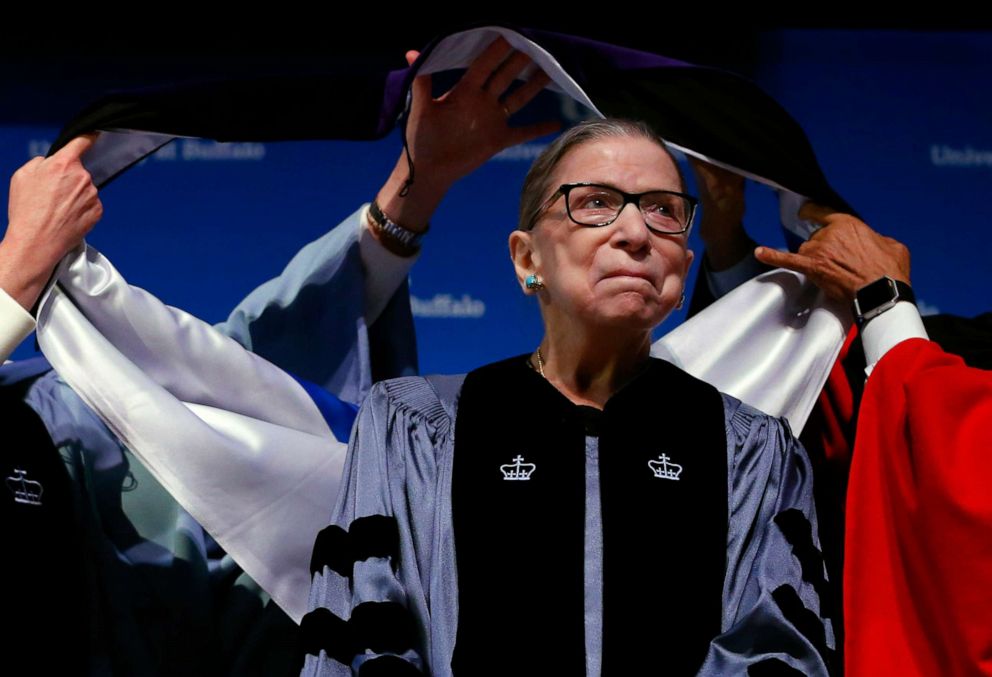
杰弗里·巴恩斯/美联社
2019年8月26日,纽约州布法罗市,最高法院助理法官鲁斯·巴德·金斯伯格出席仪式,在仪式上她获得了布法罗大学的SUNY荣誉学位
她的坚持让她的粉丝兴奋不已,巩固了她作为流行文化偶像的地位。
比尔·克林顿以前开玩笑说:“她经常在周六晚间直播节目中表演‘金斯伯格’。”挤满人的阿肯色州竞技场成千上万的RBG粉丝。“现在你可以在全世界的t恤、手提包和咖啡杯上看到她的形象。你可以对这样的人产生怨恨,但你不会。”
她的生活是2018年奥斯卡提名纪录片《RBG》和好莱坞传记片《性的基础》的主题,由费莉西蒂·琼斯和阿米·汉莫主演。
金斯伯格获得了许多荣誉学位和奖项,包括享有盛誉的伯格鲁恩奖,这是一项100万美元的荣誉,以表彰一位其思想“深刻塑造了人类在快速变化的世界中的自我理解和进步”的人物。
金斯伯格在2019年对一群杜克大学法学院的学生说:“你可以谋生,但你也可以做一些自己以外的事情,让不如你幸运的人过得更好。”
她的任期并非完全没有争议。2016年,金斯伯格投身总统竞选,公开批评推定总统候选人唐纳德·特朗普(Donald J. Trump),称他为“骗子”。
“美国最高法院的金斯伯格法官对我发表了非常愚蠢的政治声明,这让所有人感到尴尬。她脑子进水了——辞职!”当时的候选人特朗普在推特上写道。
金斯伯格后来为这些言论道歉,称其“不明智”,并承诺未来会“更加谨慎”。今年早些时候,特朗普要求金斯伯格回避“所有特朗普或与特朗普相关的问题!”她拒绝了。
她在特朗普总统任期内的死亡是她希望避免的。
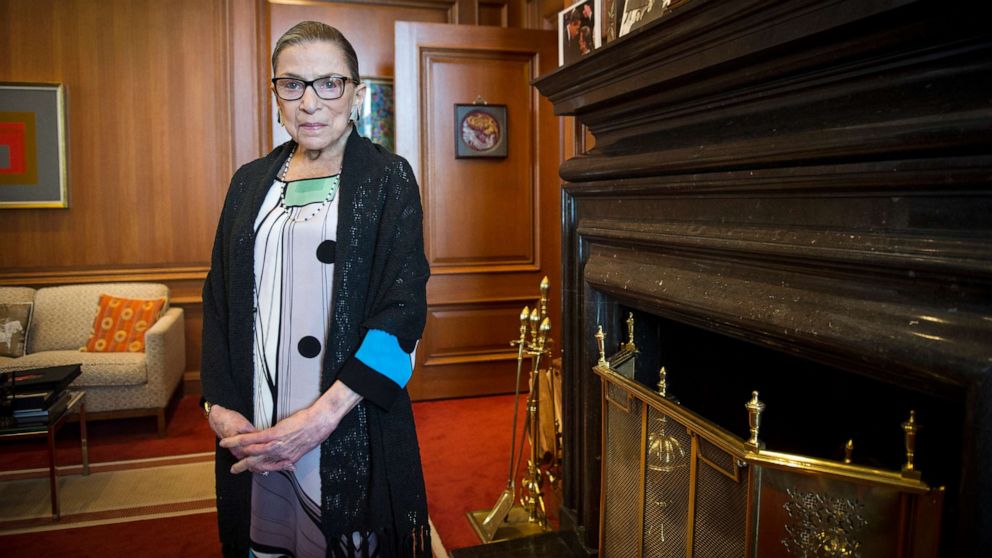
克里夫·欧文/美联社
在这张2014年7月31日的档案照片中,助理法官鲁斯·巴德·金斯伯格出现在华盛顿州最高法院的自己的房间里。最高法院称金斯伯格死于转移性胰腺癌,享年87岁。
早在特朗普当选之前,金斯伯格就拒绝了一些自由派人士提出的退休并允许民主党总统的要求巴拉克·奥巴马任命她的继任者。
“我认为这将是另一位民主党总统,”金斯伯格在2013年告诉《华盛顿邮报》。“民主党在总统选举中表现不错;他们的问题是他们无法在中期选举中获得选票。”
特朗普在2016年选举中意外击败希拉里·克林顿(Hillary Clinton)后,金斯伯格公开发誓要在法庭上保住自己的席位,“只要我健康、思维敏捷。”由于权力平衡岌岌可危,金斯伯格希望民主党总统任命她的继任者。
这个希望最终没有实现。
“纽约服装区的簿记员和最高法院的法官有什么区别?我的答案是一代人,”金斯伯格在2019年告诉北卡罗来纳州的年轻女法学院学生。
“这就是我如此乐观的原因。虽然事情看似黯淡,但我一生中经历了如此多的变化。”
Ruth Bader Ginsburg, powerhouse Supreme Court Justice, dies at 87
Ruth Bader Ginsburg, the powerhouse Supreme Court justice and champion forwomen's rights, has died at the age of 87.
"Associate Justice Ruth Bader Ginsburg died this evening surrounded by her family at her home in Washington, D.C., due to complications of metastatic pancreas cancer," Supreme Court spokeswoman Kathy Arberg said.
Her death while still serving on the Court, a scenario long-dreaded by liberals, creates a rare election-year opportunity forPresidentDonald Trumpto nominate a conservative replacement, triggering a pitched political battle.
"Our Nation has lost a jurist of historic stature. We at the Supreme Court have lost a cherished colleague," Chief Justice John Roberts said in a statement. "Today we mourn, but with confidence that future generations will remember Ruth Bader Ginsburg as we knew her -- a tireless and resolute champion of justice."
Ginsburg had become the standard bearer for thecourt's liberal wing, writing landmark opinions that advanced gender equality and rights for disabled Americans and immigrants in her more than quarter century on the bench.
She was equally known for impassioned dissents on major social issues -- fromaffirmative actionto equal pay -- which earned her a sort of rock-star status among progressives and inspired lawmakers on how to legislate social change.
"In the last 26 years, she has far exceeded even my expectations," formerPresident Bill Clinton, whoappointed Ginsburg to the court, at a 2019 event honoring the justice at his presidential library. "We like her because she seems so totally on the level in a world hungry for people who are not trying to con you, who are on the level."
Ginsburg was the second woman to sit on the high court, joiningSandra Day O'Connorin 1993, and went on to become its longest-serving woman in history. She was the first female Jewish justice.
Supreme Court Justice Ruth Bader Ginsburg, center, poses with her family at the Court in Washington, Oct. 1, 1993. From left are: son-in-law George Spera daughter Jane Ginsburg, husband Martin, son James Ginsburg. The judge?s grand children Clara Spera and Paul Spera are in front.
"Ruth Ginsburg is an inspiration," saidJustice Brett Kavanaugh, the court's newest member, in his first public speech as a justice in 2019. He called her a "dedicated, hardworking and generous soul."
Chief Justice John Robertshas called Ginsburg a "rock star."
Justice Sonia Sotomayor, the third woman and first Latina appointed to the Supreme Court, has likened her colleague to a "steel magnolia." "She's delicate on the outside," Sotomayor said of Ginsburg in 2018, "but she has an iron rod behind it."
Throughout her career, Ginsburg defied gender norms and skeptics of her mettle.
She was one of just nine women in a class of 500 students at Harvard Law School in 1956 and became the first female member of the prestigious Harvard Law Review. She later transferred to Columbia University Law School, following her beloved husband Marty who landed a job in Manhattan.
When she graduated top of her class in 1959 without a single job offer from a New York law firm, she accepted a clerkship with a federal judge in Manhattan.
Undeterred, Ginsburg pursued the law through academia, first as a researcher at Columbia and later joining the faculty of Rutgers University in New Jersey, where she became one of the first women to teach at any American law school.
In the 1970s, Ginsburg began taking up sex discrimination cases with the ACLU and co-founded the organization's Women's Rights Project. She argued six cases before the Supreme Court and won five of them.
She argued on behalf of men as well as women, part of a strategy to fight gender inequality in a way that appealed to a predominantly male judiciary. In the 1975 case Weinberger v. Wiesenfeld, Ginsburg represented a widower seeking to recover his wife's Social Security survivor benefits, which at the time were only granted to widows. She won.
"I was doing what my mother taught me to do – be a good teacher," Ginsburg told a crowd at Meredith College in North Carolina last year. "It was getting the court to understand that these were no favors to women and opening their eyes to that reality was the challenge."
President Jimmy Carterappointed Ginsburg to the U.S. Court of Appeals in 1980 where she spent 13 years and wrote hundreds of opinions. "What Jimmy Carter began was to change the complexion of the judiciary," she said of her nomination and that of 40 other women, a record.
In 1993, Justice Byron White announced his retirement from the Supreme Court, giving a young President Bill Clinton his first chance to make an appointment, just seven months after taking office. Clinton considered several candidates before settling on Ginsburg after a face-to-face Oval Office meeting.
"She was brilliant and had a good head on her shoulders. She was rigorous but warm hearted. She had a good sense of humor and sensible, attainable judicial philosophy," Clinton said recently, reflecting on his pick.
"I thought she had the ability to find common ground in a country increasingly polarized," he said. "She had already proved herself to be a healer. In short, I liked her and I believed in her."
The U.S. Senate confirmed Ginsburg on Aug. 3, 1993, by a vote of 96-3.
Chief Justice of the U.S. Supreme Court William Rehnquist administers the oath of office to newly-appointed U.S. Supreme Court Justice Ruth Bader Ginsburg as President Bill Clinton looks on, Aug. 10, 1993.
Judicial legacy
Her judicial philosophy advocated narrowly tailored, thoughtful decisions that did not get out too far ahead of public opinion or the responsibility of legislators to make policy.
Ginsburg famously lamented the Supreme Court's reasoning in its 1973 Roe v. Wade opinion, which grounded abortion rights in a constitutional right to privacy rather the principle of equal protection.
While she staunchly defended reproductive rights, Ginsburg believed the Court had gone too far, too fast, putting forward a "grand philosophy" at a time when many states were taking steps to "liberalize" abortion laws on their own.
"No measured motion, the Roe decision left virtually no state with laws fully conforming to the Court's delineation of abortion regulation still permissible," Ginsburg wrote in a 1993 Washington Post op-ed. "Around that extraordinary decision, a well-organized and vocal right-to-life movement rallied and succeeded, for a considerable time, in turning the legislative tide in the opposite direction."
She authored dozens of majority opinions in her career, earning a reputation among her colleagues for speed and accuracy.
"As a litigator and then as a judge, she changed the face of American anti-discrimination law,"Justice Elena Kagansaid of her colleague in 2014.
Ginsburg considered one of her most important opinions the 1996 case United States v. Virginia that found the Virginia Military Institute'smale-only admission policyviolated the 14th Amendment's Equal Protection clause.
"Neither the goal of producing citizen soldiers nor VMI's implementing methodology is inherently unsuitable to women," she wrote in an opinion joined by five of her colleagues. "And the school's impressive record in producing leaders has made admission desirable to some women."
FILE PHOTO: The first female supreme court justice, Sandra Day O'Connor, speaks as fellow Justice Ruth Bader Ginsburg listens during a forum at the Newseum, in Washington, April 11, 2012, to mark the 30th anniversary of O'Connor's first term on the Supreme Court.
In her memoir, My Own Words, Ginsburg writes that she regards the case as "the culmination of the 1970s endeavor to open doors so that women could aspire and achieve without artificial constraints."
In 1999, Ginsburg delivered the majority opinion in Olmstead v. L.C. which affirmed the right of Americans with disabilities to receive state-funded support and services in their communities, instead of only designated institutions.
"We confront the question whether the proscription of discrimination may require placement of persons with mental disabilities in community settings rather than in institutions," she wrote. "The answer, we hold, is a qualified yes."
As the court moved to the right, Ginsburg often challenged her colleagues with polite but impassioned dissents.
One of her most famous dissents came inBush v. Gore, which brought an end to the contested 2000 election and cleared the way for George W. Bush to claim the presidency. "I dissent," Ginsburg wrote sharply, breaking with the customary "I respectfully dissent" in a subtle protest.
"There's never been a case like Bush v. Gore before or since. From the day of that decision, continuing to this day, the Court has never cited it as precedent in any other case, and I think it will remain that way," she said in a lecture in 2014.
Defendingabortion rightswas a hallmark of her tenure. In 2007, Ginsburg blasted a narrow 5-4 decision in Gonzales v. Carhart upholding a ban on intact dilation and extraction abortions as "quite simply irrational."
"The notion that the Partial-Birth Abortion Ban Act furthers any legitimate governmental interest is, quite simply, irrational," she wrote in her dissent. "The Court's defense of it cannot be understood as anything other than an effort to chip away at a right declared again and again by this Court -- and with increasing comprehension of its centrality to women's lives."
Occasionally lawmakers used Ginsburg's dissents as inspiration for new legislation.
When the Court in 2007 upheld a statute of limitations for pay discrimination claims against Goodyear Tire, Ginsburg read her dissent from the bench and proposed a legislative fix.
"In our view, the court does not comprehend, or is indifferent to, the insidious way in which women can be victims of pay discrimination," she said.
In this June 15, 1993, file photo, President Bill Clinton applauds as Judge Ruth Bader Ginsburg prepares to speak in the Rose Garden of the White House, after he announced he would nominate her to the Supreme Court.
Two years later, after action by Congress, President Barack Obama signed theLily Ledbetter Fair Pay Act, named after the woman who had sued Goodyear and lost at the Supreme Court, extending the statute of limitations for future unequal pay claims. A framed copy of the law hung in Ginsburg's chambers.
"The idea that the dissent put forward was the soul of simplicity," Ginsburg later said. "It said, 'Every paycheck that this woman receives is renewing the discrimination, so she can sue within 180 days of her latest paycheck, and she will be on time.' That's what Congress said: 'Yes, that's what we meant.'"
"If there was one decision I would overrule, it would beCitizens United," she told law professor Jeffrey Rosen of the landmark 2010 decision lifting corporate spending limits in campaigns. "I think the notion that we have all the democracy that money can buy strays so far from what our democracy is supposed to be. So that's No. 1 on my list."
In 2013, Ginsburg strongly opposed the Court's controversialShelby County v. Holder decisionthat struck down a key portion of the 1965 Voting Rights Act requiring state and local governments with a history of discrimination to get preclearance from the Justice Department before changing voting laws.
"Throwing out preclearance when it has worked and is continuing to work to stop discriminatory changes is like throwing away your umbrella in a rainstorm because you are not getting wet," Ginsburg wrote in her dissent.
The opinion gave rise to a newnicknamefor Ginsburg --"Notorious R.B.G."-- coined by an NYU law school student as a play on the late rapper Notorious B.I.G.
"She was angry, and then it came to her that anger is a useless emotion," Ginsburg said of the student. "And the positive thing she did was to put on her blog my dissenting opinion in the case and then it took off from there."
In 2012, Ginsburg wrote what longtime court reporter Jeffrey Toobin called "probably the most powerful opinion of her career" endorsing the constitutionality of the Affordable Care Act.
"Unlike the market for almost any other product or service, the market for medical care is one in which all individuals inevitably participate," she wrote, defending Congress' sweeping power under the Constitution's commerce clause. "Virtually every person residing in the U.S., sooner or later, will visit a doctor or other health care professional."
"Dissents speak to a future age," Ginsburg told NPR's Nina Totenberg in 2002. "The greatest dissents do become court opinions and gradually over time their views become a dominant view. So that's the dissenter's hope: that they are writing not for today but for tomorrow."
Associate Justice Ruth Bader Ginsburg sits with her colleagues on the United States Supreme Court during a group portrait after Associate Justice Brett Kavanaugh joined the court on Nov. 30, 2018, in Washington.
While she would clash with her colleagues ideologically, Ginsburg extended a hand of friendship to even her most conservative peers, including, famously, the lateJustice Antonin Scalia.
"When he was nominated, although his views were very well known, he was confirmed unanimously. And I came pretty close to that -- the vote on me was 96 to 3," Ginsburg said of her friend in a recent conversation with the law professor Rosen. "It would not be that way today, but don't you think that's the direction in which we should seek to return?"
Ginsburg and Scalia shared a love of opera, occasionally attending performances together at the Kennedy Center. The duo was also the subject of an opera -- "Scalia/Ginsburg" -- written by a University of Maryland law school student. Ginsburg's favorite duet in the work is titled "We Are Different, We Are One."
"The idea is that there are two people who interpret the Constitution differently yet retain their fondness for each other and, much more than that," she said, "their reverence for the institution that employs them."
Brooklyn-born and activist roots
Born Joan Ruth Bader in Brooklyn, New York, in 1933, she was the second daughter of Jewish immigrants.
"I am … a first generation American on my father's side, barely second generation on my mother's," Ginsburg told the Senate Judiciary Committee in her confirmation hearing. "Neither of my parents had the means to attend college, but both taught me to love learning, to care about people, and to work hard for whatever I wanted or believed in."
She credited her mother -- a garment factory worker -- as being one of the greatest influences on her life. "My mother told me two things constantly," Ginsburg said in a recent interview with the ACLU. "One was to be a lady, and the other was to be independent."
Ginsburg also deeply loved and valued her husband, Marty, whom she met as an Cornell University undergraduate and married in 1954. Together they were lawyers and co-partners both in advocacy for women and in parenthood.
"I have had more than a little bit of luck in life, but nothing equals in magnitude my marriage to Martin D. Ginsburg," she wrote in her memoir. "I do not have words adequate to describe my super smart, exuberant, ever-loving spouse."
The couple had two children together -- Jane and James -- forging a strong family bond for 56 years up to his death from cancer in 2010.
"I certainly wouldn't be here today were it not for Marty because he made me feel that I was better than I thought I was," she said at an event in January 2018. "He had a great sense of humor and another very important strength -- he was a wonderful cook."
Late-in-life pop culture icon
Ginsburg showed remarkableresilience late into life.
She survivedfour battles with cancerover her Supreme Court career, never having to recuse herself from casework because of illness. In December 2018, she was absent from oral arguments for the first time in 26 years after undergoing lung cancer surgery, but she participated in the cases remotely. During the coronavirus pandemic, she joined oral arguments by phone from a Maryland hospital where she was being treated for a gallbladder infection.
Even as the court's oldest member, she maintained one of the most aggressive public schedules of any of her peers, regularly traveling the country in her final years.
"I think my work is what saved me because instead of dwelling on my physical discomforts if I have an opinion to write or brief to read I know I've just got to get it done and have to get over it," she said last year.
Her workout regimen became the stuff of legends, performing push-ups, holding abdominal planks and pumping weights late into her 80s. When the Court employee gym shutdown during COVID-19, Ginsburg continued to do her workouts in a special isolated fitness space set up at her request. Her personal trainer, Bryant Johnson,memorialized her routinein the 2017 book, "The RBG Workout: How She Stays Strong… And You Can Too!"
Even after receiving radiation treatment for a pancreatic tumor in 2019, Ginsburg told a crowd at the University of California Berkley that she "never left" the gym.
"Even in my lowest periods I couldn't do very much, but I did what I can," she said.
Supreme Court Associate Justice Ruth Bader Ginsburg attends a ceremony where she received a SUNY Honorary Degree from the University at Buffalo, Aug. 26, 2019, in Buffalo, N.Y.
Her persistence electrified her fans and solidified her status as a pop culture icon.
"Regularly she's portrayed on [Saturday Night Live] delivering her 'Ginsburns,'" joked Bill Clinton beforea packed Arkansas arenaof thousands of RBG fans in 2019. "And now you can see her image on T-shirts, totes and coffee mugs the world over. You can become resentful of such a person, but you're not."
Her life was the subject of a 2018 Oscar-nominated documentary -- "RBG" -- and a Hollywood biopic -- "On the Basis of Sex" -- starring Felicity Jones and Armie Hammer.
Ginsburg was the recipient of numerous honorary degrees and awards, including the prestigious Berggruen Prize, a $1 million honorarium to recognize a figure whose ideas have "profoundly shaped human self-understanding and advancement in a rapidly changing world."
"You can earn a living but you can also do something outside yourself that will make things a little better for people less fortunate than you," Ginsburg told a group of Duke University law school students in 2019.
Her tenure was not entirely without controversy. In 2016, Ginsburg waded into the presidential campaign with public criticism for the presumptive presidential nominee, Donald J. Trump, whom she called a "faker."
"Justice Ginsburg of the U.S. Supreme Court has embarrassed all by making very dumb political statements about me. Her mind is shot -- resign!" then-candidate Trump tweeted at the time.
Ginsburg later apologized for the remarks, calling them "ill-advised" and promising to be "more circumspect" in the future. Earlier this year, Trump demanded that Ginsburg recuse from "all Trump, or Trump related, matters!" She declined.
Her death during the Trump presidency was something she had hoped to avoid.
In this July 31, 2014, file photo, Associate Justice Ruth Bader Ginsburg is seen in her chambers in at the Supreme Court in Washington. The Supreme Court says Ginsburg has died of metastatic pancreatic cancer at age 87.
Well before Trump's election, Ginsburg rebuffed calls from some liberals to retire and allow Democratic PresidentBarack Obamato name her successor.
"I think it's going to be another Democratic president," Ginsburg told The Washington Post in 2013. "The Democrats do fine in presidential elections; their problem is they can't get out the vote in the midterm elections."
After Trump's surprise defeat of Hillary Clinton in the 2016 election, Ginsburg publicly vowed to hold her seat on the court "as long as I'm healthy and mentally agile." With the balance of power at stake, Ginsburg wanted a Democratic president to name her replacement.
That hope ultimately went unfulfilled.
"What is the difference between a bookkeeper in the New York garment district and a Supreme Court justice? My answer is one generation," Ginsburg told young women law students in North Carolina in 2019.
"That's why I'm such an optimist. As bleak as things may seem, I have seen so many changes in my lifetime."






